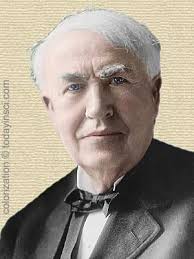
Photographers
Thomas Edison
1847 — 1937
"I am experimenting upon an instrument which does for the eye what the phonograph does for the ear, which is the recording and reproduction of things in motion ." --Thomas A. Edison, 1888
Edison, an incredible creator, patented 1,093 inventions. These included the phonograph, the kinetograph (a motion picture camera), and the Kinetoscope (a peep-hole motion picture viewer). Motion pictures became a successful entertainment industry in less than a decade, with single-viewer Kinetoscopes giving way to films projected for mass audiences. The Edison Manufacturing Co. not only built the apparatus for filming and projecting motion pictures, but also produced films for public consumption.
The Edison laboratory worked as a collaborative organization. Laboratory assistants were assigned to work on many projects while Edison supervised and participated to varying degrees. In August, 1889, he went to Paris for the Exposition Universelle. He met Étienne-Jules Marey who was involved in Chronophotography, a photographic technique from the Victorian age which studied locomotion for physiological research. Upon his return home he filed another patent caveat which described a Kinetoscope based not just on a flexible filmstrip, but one in which the film was perforated to allow for its engagement by sprockets, making its mechanical conveyance much more smooth and reliable. Edison also worked with George Eastman and with his flexible film. Fully understanding the many processes that Edison's team used to be successful in photography is not possible in a few paragraphs.
Thomas Alva Edison is a member of the Silver Hall of Fame for his creations that greatly enhanced the use of silver in moving photography.
Last Updated on: 2024-02-28
